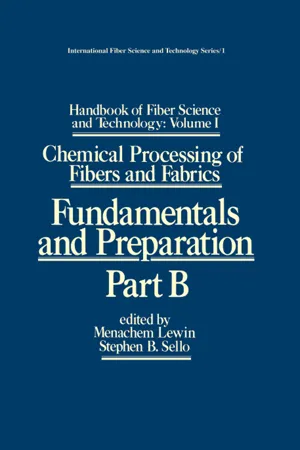![]()
1
MATERIALS AND PROCESSES FOR TEXTILE WARP SIZING
PETER G. DREXLER / Chem-Mark, Inc., Middlesex, New Jersey
GIULIANA C. TESORO* / Department of Mechanical Engineering, Massachusetts Institute of Technology, Cambridge, Massachusetts
1. Introduction and General Considerations
1.1 Purpose of sizing
1.2 Critical requirements of the size
2. Substrates
2.1 Natural fibers
2.2 Man-made fibers
3. Polymers for Sizing
3.1 Starch and starch derivatives
3.2 Carboxymethyl cellulose
3.3 Acrylic polymers
3.4 Polyvinyl acetate
3.5 Polyvinyl alcohol
3.6 Polyester dispersions
3.7 Polyurethanes
3.8 Styrene copolymers
3.9 Solvent systems
3.10 Hot-melt sizing polymers
4. Sizing Machinery and Processing Technology
4.1 Conventional procedures
4.2 Short liquor processes
4.3 Solvent slashing
4.4 Hot-melt processing
4.5 Miscellaneous innovations
5. Desizing
5.1 Hydrolytic processes
5.2 Oxidative processes
5.3 Alkaline scour processes
5.4 Solvent desizing
5.5 Low-temperature plasma treatment
5.6 Desizing by thermochemical extraction and coronization (glass)
5.7 Durable sizes
6. Size Recovery and Recycling
References
1. INTRODUCTION AND GENERAL CONSIDERATIONS
1.1 Purpose of Sizing
The primary purpose of sizing—an important step in preparation for weaving known as warp slashing—is to attain optimum weaving efficiency. The process requires selection of sizing materials that are appropriate for the specific warp yarns, of formulations, and of processing conditions which are suitable for the equipment used.
The evolution of sizing technology in the textile industry has a long history. When mechanical weaving gained momentum in the second half of the nineteenth century, attention was focused on breakage of warp yarns made from natural fibers (silk, cotton, and wool), which at the time were used without protective lubricants. In later years, soap solutions, gelatine, tallow, linseed oil, and starch dispersion were applied to the yarns to minimize damage by abrasion, and about sixty years ago the processes were investigated in some depth at the Shirley Institute in Great Britain. The flow properties of the applied materials were examined, and the fundamental principles of rheological behavior were recognized, although the term “rheology” had not yet been coined [1, 2, 3, 4, 5].
The current concepts of sizing are thus based on half a century of pragmatic technological advances in the mills, coupled with new knowledge and developments in the fields of polymer science, fiber science, and chemical manufacturing.
A warp size may be defined as a film-forming polymeric material which is applied to a sheet of yarns for the purpose of protecting it during the weaving process, in which warp yarns are subjected to high abrasion (e.g., at the sites of drop wires, split rods, heddles, reed, shuttle). In the case of staple yarns like cotton, the size partially encapsulates the yarn and shields defects such as weak spots, knots, or crossed ends which occur in normal yarn production. The size also envelops protruding fibrils, lessening friction. When filament yarns like acetate or nylon are sized, the filaments are aligned to prevent chafing. The degree of penetration of the yarn by the size depends on the system, but in all instances, a protective coating is formed on yarn surfaces.
The size is generally applied from solution to a sheet of yarns which travels at a speed of 45–300 m/min and is then dried to very low moisture content on heated rolls. After drying, the yarns in the warp sheet are separated (“split”) by an assortment of bars. No yarn breakage occurs if the adhesive strength of the size is sufficiently high, and no shedding of size if essentially complete encapsulation of the yarn is attained.
The size formulation is generally prepared and kept for several hours at elevated temperature, and it should be stable under these conditions. In the weaving room, humidities are usually high, and the dried film or protective coating of size should not become tacky. After weaving, easy removal of size (desizing) and freedom from residual deposits in the fabric are important requirements.
Many sizes are applicable to yarns made from a broad spectrum of fibers, both natural and synthetic. However, no universal size which can exhibit all the desired properties on all substrates is available, and each sizing system has specific shortcomings or limitations. The requirements for sizing yarns made from natural and from synthetic fibers are different, and only a few polymeric systems can bridge this gap. Furthermore, for each sizing system, consideration must be given to environmental effects of materials released into public streams, and the need for completely biodegradable sizes is considered acute at this time. On the other hand, energy constraints suggest that biodegradability of sizing materials may not be the ultimate answer and that recoverability and recycling of sizes may best serve the commercial interests of the textile manufacturing industries in the future.
1.2 Critical Requirements of the Size
With a focus on the film-forming polymer which is the dominant constituent of all size formulations, a discussion of the critical requirements of sizing materials should distinguish several categories of properties that are determined by different system parameters and that have important effects on yarn performance in the sizing and desizing processes. These may be described, for example, as follows:
1. Properties that depend primarily on the molecular structure of the film-forming polymer, namely, solubility/dispersibility, tensile strength, elongation, abrasion resistance, and moisture response.
2. Properties that determine the behavior of sized yarn, namely, adhesion, flexibility, lubricity, transparency, and mildew resistance.
3. Properties related to ease of processing and to conditions of application, namely, compatibility (in the formulation), lack of corrosiveness of solutions, viscosity and rheology of solutions, penetration, foaming, skinning of solutions, fiber lay, uniformity, and ease of removal.
Even with such distinctions, it is difficult to discuss clearly this complex array of principles and pragmatic definitions of performance. Some of the most important requirements of sizing formulations for optimal warp preparation and weaving efficiency are briefly reviewed below as background for the overview which follows.
Adhesion
The adhesion of the size to the yarn substrate is critically important. Yarn surfaces vary in structure and geometry, depend...
